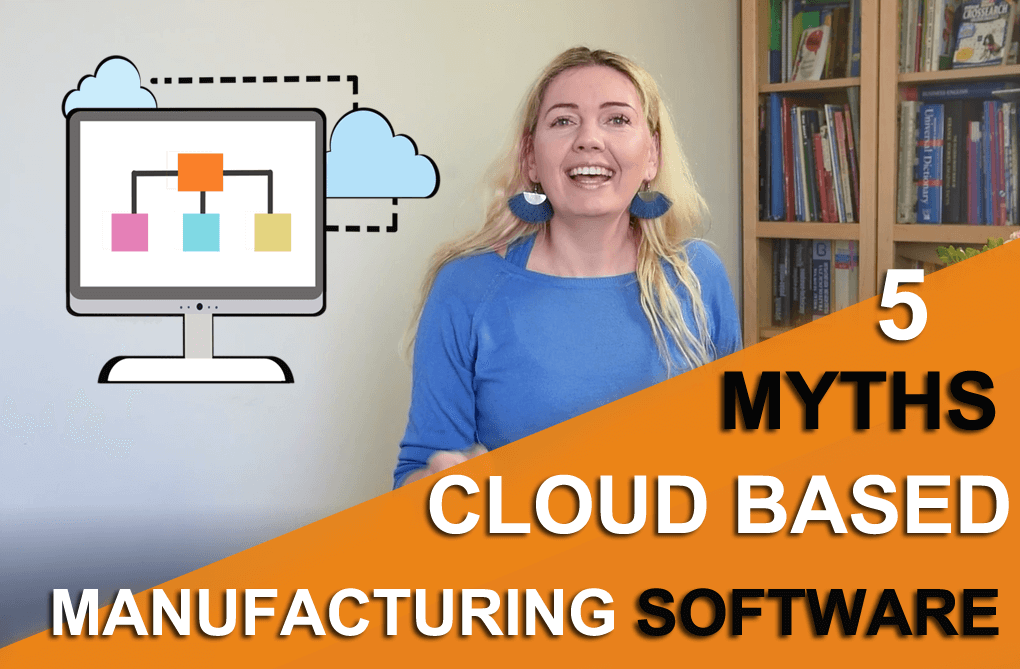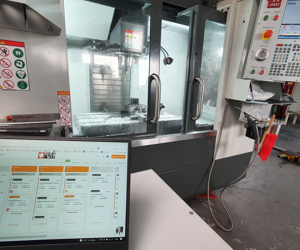Has it ever happened to you that you got a seemingly very profitable order, but after covering all expenses, you barely had anything left out of the profits? Every manufacturer had such a situation at least once – and for some, this is a regular occurrence. The culprit? Very often, cost of production.
Material costs, direct labor, overhead costs – all of those affect how much profit a company makes. That’s why it’s essential to know what makes up these costs – and what you can do to reduce those.
So in this blog post, we’ll look at what is included in the production costs and how they’re calculated. We’ll also give a few tips on how you can slash the production expenses, to help you save money, become more efficient, and stay competitive.
What is the Cost of Production?
The cost of production is the total expense associated with manufacturing a product or providing a service. These costs include materials costs and labor but also various indirect costs such as utilities or maintenance. So basically, all expenses related to producing a product or providing a service can be considered production costs.
By understanding their own production costs, manufacturers can spot places where they are losing money and reduce their expenses. Analyzing production costs can also be very helpful in figuring out what parts of the production process you can optimize – both for lower costs and better efficiency.
What is the difference between the cost of production and manufacturing costs?
Before we get to the details, there’s one thing we need to clarify. Namely, manufacturing and production costs aren’t the same, even though many people use those terms interchangeably.
Manufacturing costs only include the expenses connected to making a product – like the direct material costs or labor hours.
Production costs meanwhile also cover various other expenses related to running the business – such as the salaries of maintenance workers or sales team.
So, Production costs = Manufacturing costs + other expenses related to running the business.
Different Types of Production Costs
Let’s now examine what is included in the production costs in more detail.
Material Costs
Material costs include all expenses connected to the raw materials or other supplies needed for the production process. They are directly related to production volume – the more products are made, the higher the material costs.
Labor Costs
Labor costs are the sum of all wages manufacturers pay their employees for their work, together with their benefits and taxes. We can broke those into direct and indirect expenses:
- Direct costs are wages and benefits for the employees that are involved in the production process directly (for example, workers on an assembly line)
- Indirect costs meanwhile are associated with salaries and benefits for employees that don’t work on the main production lines but instead help the company run smoothly (for example, maintenance and repair crew)
Overhead Costs
Overhead costs, also known as indirect costs, are the costs that can’t be directly linked to the production of specific goods or services. These include utilities, rent, office supplies but also the cost of wasted or damaged materials.
What methods do manufacturers use to calculate the costs?
Depending on their production type, manufacturers typically use those two methods to calculate their costs:
Process Costing
Most industries that develop mass-produced products use process costing to calculate their costs. It’s a simple method of calculating the production costs as it divides the total production expenses by the number of units produced. As a result, we get an average cost per unit.
Activity-Based Costing
For manufacturers that create customized products or run short production series, activity-based costing often works better. Instead of dividing the number of products by the cost, ABC instead analyzes how much resources each activity required and calculates the cost based on this. A massive advantage of this method is that it can more accurately reflect the cost of production, as it includes non-production costs as well. ABC costing method is often also very useful for calculating the cost of services.
However, this method is also a bit trickier to get it right – especially for smaller businesses.
The challenges of activity-based costing
In the ABC method, business owners need to track how many resources each activity in the production process used and then, based on that, determine how much each production step costs. For smaller companies that still run on the traditional pen-and-paper method, this might be very hard to do though.
- There’s no single method to add how much time and materials were used during the production.
- The spreadsheets are created or updated by different people as there are often not enough employees to assign someone just to manage the spreadsheets.
- Work efficiency and time might vary widely depending on the employees’ skills, experience and conditions.
- With customized products, the time and resources needed vary from project to project, so they are very often guesstimated.
As a result, tracking production activities and resources can quickly become chaotic. Cloud-based tools for monitoring production time, efficiency, and expenses can make implementing the Activity-based costs method far smoother though, as they can automatically track how much time each activity took. We’ll show you in a moment how exactly tools such as our Prodio can make this possible.
First, let’s look at how different types of production costs should be calculated.
How to calculate different production expenses
What can make calculating the production cost even more complicated is that the costs themselves can belong to different categories. Let’s take a quick look at them and how you can calculate those.
Fixed costs
Fixed costs are expenses that remain the same regardless of the production volume and demand. Rents, salaries, and utility bills are good examples of fixed costs, as companies pay the same amount each month.
Variable costs
Unlike fixed costs, variable costs regularly change depending on production needs. Therefore, these costs will increase as production increases and decrease when production falls.
We can use raw materials and direct labor costs here as an example.
Example: If each unit of a product requires $5 of material and 100 units are made, the variable cost is $500. But if only 10 units are produced, then the variable cost will be $50.
Total cost
Total cost is the sum of all fixed and variable costs involved in producing a certain amount of goods.
Example: A company has fixed costs of $10,000 and variable costs of $5,000 for a month. Their total cost for that month is $15,000.
Marginal cost
Marginal cost is the cost of producing one additional unit, for example, because one of the products failed the quality control.
Example: If the total cost of producing 100 units is $1,000 and the total cost of producing 101 units is $1,010, the marginal cost of the 101st unit is $10.
Average costs of production
The average cost of production is the total cost (average fixed costs+variable costs) divided by the number of goods produced.
Example: The total cost to make 100 units is $1,000. The average cost per unit is $10 ($1,000 / 100 units).
Opportunity Costs
Opportunity cost is what a given manufacturer will miss when choosing one option over another.
Example: If out of two products (A and B), the manufacturer decides to produce only product A, then the potential profit they are losing from not making Product B is the opportunity cost.
Popular practices to control production costs
Strategic Sourcing and Supplier Management
One of the clever ways in which you can lower your production costs in the long run is strategic sourcing.
Strategic sourcing is comparing different suppliers based on specific business requirements and then picking the one that brings the most value at the lowest costs. What’s very important to note here is that this method isn’t about hiring “the cheapest” provider there is.
Instead, it’s about finding and then building a relationship with a supplier that meets the business requirements the most, allowing the company to save money in the long term.
Inventory Management
A good part of the production costs also come from managing the inventory manually. For example, how many times a week do your workers have to search for missing materials? Or how many times have you overstocked because the amount of materials in the Excel file was wrong? Probably too many, too often.
An automated inventory management system with bar-coded labels could keep the inventory in order for you. Plus, by knowing how many raw materials you have at the moment (and how many you will need for the next production batch), you can precisely order exactly the amount of resources you will need.
Implementing a Just-in-time (JIT) inventory management system might also be a good idea.
Labor Cost Reduction
Another place where you can cut your costs is in labor costs. And we absolutely don’t mean here you should cut wages or double the norms for your workers – absolutely not. But there are a few ways in which you can boost your workers’ productivity – and this way, cut labor costs.
For example, with our Prodio online production planning, workers no longer need to walk around the shop floor or call several workers to ask about the production progress. Instead, they will have all the production information right on their dashboard – from what machines are occupied and by who and what tasks are already completed.
That way, workers can save plenty of the time that they usually have to spend to find out whether they can start working or not yet.
Process Improvement for Efficiency
One more benefit of online production planning is that it can make your entire production process much more efficient as well. By seeing at what stage your production is now and what elements are already finished, you can take better decisions on what you should do next.
Plus, as the workers can immediately add to the schedule any issues they notice during the production process (such as a malfunctioning machine), which will help to reduce material waste and marginal costs as well.
Overhead Cost Reduction
Reducing overhead costs can also help to lower production costs. By analyzing your main overhead costs, you can find out where exactly you are losing money and what you can do to save your budget. For example, you could adopt energy-efficient technologies and practices to reduce utility costs. By scheduling regular equipment checkups, you can also faster spot any signs of wear down or malfunction and fix the issues in advance, reducing repair costs.
Real-time view of expenses as a way to reduce the production costs
If we had to say what, in our opinion, might be the biggest reason why so many production orders turn out to be unprofitable in the end, we would say it’s lack of control over the costs.
Plenty of manufacturing companies are still managing (or rather, trying to manage) their production costs with Excel spreadsheets or paper notes. With how many different expense types there are though, keeping track of them manually is nearly impossible though. What’s more, the data typed into spreadsheets is often already outdated the moment it’s added to the spreadsheets.
Results? The production costs inside the spreadsheets might be completely different from the actual production costs – and the business owners often have no idea where the differences even came from.
How can production tracking control tools such as our Prodio help with lowering production costs?
Fortunately, modern technology does have a solution to this problem. Namely, cloud-based platforms for the manufacturing industry that can monitor the production costs and then automatically turn the data into reports for the business owners.
Here’s how it looks like in our Prodio:
- When starting work on a task, workers click on the “Start” button. The app will then track how much time it takes them to complete a given task.
- Workers add how many elements they finished during that time and how many materials they used for the task.
- If there were any issues during the production process, they can include those in task comments.
Based on the information, Prodio will then calculate how much the entire production has cost and then break down the amount into machine and resources cost, labor costs and others. And as the application will update the production expenses automatically, you can be sure that the data inside the system will be up-to-date.
By seeing how much each production stage costs you and what is included in the costs, you can better track your production expenses. And with online production progress tracking, workers won’t have to waste time searching through the entire shop floor for someone who knows what stage the production now is.
Want to see how Prodio works in practice? Give it just 15 minutes for installation, and you can start using the online production schedule (and tons of other features) straight away.
Conclusion
Navigating the labyrinth of production costs is no simple task. You have to keep an eye on not only on the tangible costs directly tied to manufacturing but also the indirect costs that stealthily impact the bottom line. Impossible? Not with tools like our Prodio. One-click inside the app and you’ll be able to see how much resources your staff has used, which machines were used the most and even keep an eye on your workers’ performance. So that way, finding out why your recent order turned out to be unprofitable and what you can do to prevent such a situation every again will be a breeze. Not to mention, you’ll be able to say goodbye to the dozens of spreadsheets you have to update every day – and that’s something you and your workers will surely appreciate as well.
Production cost FAQ
What are the components of production costs?
Production costs are made of three elements:
- Material costs (raw materials and supplies).
- Labor costs (direct labor involved in production).
- Overhead costs (indirect costs like utilities and maintenance).
How can a manufacturing company lower its production costs?
There are several methods you can use to reduce the costs. For example, you can analyze your overhead costs to find places where you could reduce those or implement a manufacturing automation platform to reduce the time spent on mundane tasks.
What strategies can be applied for effective inventory management in manufacturing?
Implementing an inventory management platform can make keeping track of the raw materials much easier, enabling factories to use their resources more effectively. A good idea might also be to use the Just-in-time inventory management method, which connects the ordering of raw materials to production schedules.
How does process improvement impact labor costs?
By optimizing and improving your processes, you can significantly boost workers’ efficiency and productivity but also lower the amount of resources needed or wasted during production. This results in lower labor costs per unit produced.
How can energy efficiency lead to cost reduction in manufacturing?
By being energy efficient, companies can reduce their utility costs, which are often a significant portion of the overhead costs. This can be achieved by using energy-efficient devices, optimizing usage or negotiating better rates with the utility providers.
How does automation affect the cost of production?
Automation can reduce labor costs, increase efficiency, and minimize errors in production, thereby reducing overall production costs in the long run.


 Marek Mrowiec
Marek Mrowiec 

